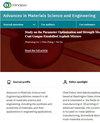Processability of Pultrusion Using Natural Fiber and Thermoplastic Matrix
4区 材料科学
Q2 Engineering
引用次数: 10
Abstract
Fundamental mechanisms of the pultrusion process using commingled yarns of polypropylene matrix and discontinuous flax fiber to produce thermoplastic profiles were investigated in numerical and experimental manners. Essential issue is the fact that all natural fibers are discontinuous by nature, which may negatively influence the processability. The pultrusion process will be only successful if the pulling force exerted on the solidified pultrudates can be transmitted to the regions of unmelted commingled yarns by “bridging over” those melted regions within the die. This can be realized by applying a sufficient number of small yarn bundles of high compactness rather than a thicker single bundle of lower compactness as the raw material. Furthermore, the possibility of adding extra melt into the yarn bundles by side-fed extrusion has been investigated showing that the impregnation can be improved only for the outer layers of yarns, which is owed to the high viscosity of the thermoplastic melt and the limited length of the die.天然纤维和热塑性塑料基体拉挤的可加工性
采用数值和实验方法研究了聚丙烯基混纺纱与亚麻纤维混纺纱生产热塑性型材的基本机理。关键问题是所有天然纤维本质上都是不连续的,这可能会对加工性能产生负面影响。只有当施加在固化拉挤料上的拉力能够通过“桥接”在模具内熔化的区域传递到未熔化的混纺纱区域时,拉挤过程才会成功。这可以通过使用足够数量的高紧致度的小纱束来实现,而不是使用较粗的低紧致度的单纱束作为原料。此外,研究了通过侧送挤压向纱束中添加额外熔体的可能性,结果表明,由于热塑性熔体的高粘度和模具长度有限,只能改善纱线外层的浸渍。
本文章由计算机程序翻译,如有差异,请以英文原文为准。
求助全文
约1分钟内获得全文
求助全文
来源期刊

Advances in Materials Science and Engineering
Materials Science-General Materials Science
CiteScore
3.30
自引率
0.00%
发文量
0
审稿时长
4-8 weeks
期刊介绍:
Advances in Materials Science and Engineering is a broad scope journal that publishes articles in all areas of materials science and engineering including, but not limited to:
-Chemistry and fundamental properties of matter
-Material synthesis, fabrication, manufacture, and processing
-Magnetic, electrical, thermal, and optical properties of materials
-Strength, durability, and mechanical behaviour of materials
-Consideration of materials in structural design, modelling, and engineering
-Green and renewable materials, and consideration of materials’ life cycles
-Materials in specialist applications (such as medicine, energy, aerospace, and nanotechnology)
 求助内容:
求助内容: 应助结果提醒方式:
应助结果提醒方式:


